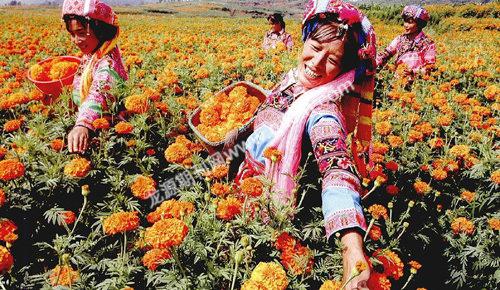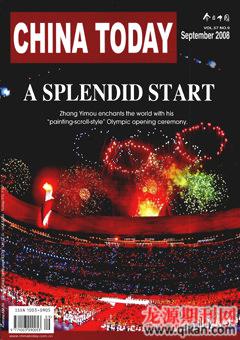The Development of an Agricultural City
LIU HUANZHI
THE mountain road spiraled up and down along the Wumeng range, revealing a rolling expanse of vibrant green. Parcels of flat land lay interspersed between lush hills, where vegetables, tobacco, medicinal herbs, flowers, fir trees and potatoes grow.
I visited the agricultural city of Qujing over the summer, and its hilly pastoral vistas in eastern Yunnan Province, on the border with Guizhou, left a deep impression. To answer the central governments call for the further development of the provinces agriculture, its villages and the lives of farmers, the municipal government of Qujing has concentrated its efforts over the past several years on promoting a high-quality, high-efficiency and ecologically friendly agriculture, with great success.

An Agriculture of Scale
“Qujing is both a major agricultural producer and a heavily populated city in Yunnan,” said Liu Haifang, deputy mayor in charge of agriculture. “In recent years, the municipal government has identified agricultural growth as its highest priority, and has promoted large-scale modern agricultural operations, making the city a provincial leader in the field.”
According to the deputy mayor, Qujing has formed eight agricultural zones, each concentrating on the production and processing of a particular crop or two. For example, its cultivation and processing of marigold and konjac is the most intensive in the country, and the output, production value and processing capabilities of its animal husbandry operations lead Yunnan Province.

Today, the citys agriculture has developed quickly on the basis of scale operations along six lines — animal husbandry, grain and oil-bearing crops, seed production, yam and related tubers, sericulture, vegetables, cut flowers, fruits and fruit trees. “Agricultural science and technology, as well as the showcase role of industrial leaders, are the two greatest contributors to the citys agricultural breakthroughs in recent years,” said Zhu Dangzhu, director of the municipal agricultural bureau.
The city has established pre-, mid- and post-production technical support and service systems, and the material gains of agricultural technical workers are closely linked to the results of their work in promoting and applying agricultural science and technology.
The role of industrial leaders is crucial in the application of agricultural technology and in the promotion of an efficient modern agriculture. In 2007, Qujing had 160 large-scale agricultural operators, with combined fixed assets amounting to RMB 2.086 billion, and total assets exceeding RMB 4.366 billion. During the same year, they realized a total sales income of RMB 4.712 billion, earned a net profit of RMB 273 million, created US $41.14 million in export, and brought about an increase of farmers incomes by RMB 1.198 billion.

The Qujing Bohao Biotech Co., Ltd., for example, specializes in marigold plantations and deep processing. It has its own plantation and processing facilities, and also contracts local farming households to act as raw material suppliers. In five years, it has grown into Chinas largest marigold supplier and lutein extract producer, with total assets of RMB 100 million.
Animal Husbandry
“Livestock raising has become a major source of rural economic growth, and has accounted for a dramatic increase of farmers incomes. For the majority of farmers, around 50 percent of their incomes come from livestock,” said Wang Zongji, head of the municipal animal husbandry bureau. Qujings animal husbandry has maintained a steady growth for 29 consecutive years, and in recent years that growth has been marked by improvements in both quantity and quality, Wang said.
The municipal government has promoted animal husbandry as the citys pillar industry, and pooled individual stock raisers, area by area, into an organized operation that follows set standards with regard to facilities, breeds, operations, quarantine procedures and safety management. These stock-raising communities have not only upgraded their operational modes of animal husbandry, but have also helped accelerate the construction of a new countryside.
A group of industrial leaders has emerged from these industrial pools. They have developed their own characteristic products, and consequently their economic efficiency. Today, the city has 60 large-scale stock raisers, including six provincial leaders and 18 municipal leaders in the field. Last year, they realized a business income of RMB 2.66 billion. These large-scale operators also work in close cooperation with 533,200 local stock-raising households, securing their financial well-being in the process.
Director Wang Zongji believes that these leading businesses are crucial to promoting large-scale animal husbandry operations, which will promote the development of individual farming households. The governments role has been to provide them with needed policy support, and to exercise tight control over animal disease prevention and quarantine, product quality and safety, and public health safety management.
Poverty Relief
Qujing has an abundance of natural resources and is famed as the “source of the Pearl River,” which originates in the citys Maxiong Mountains. However, 720,000 of its population of 6 million still live in poverty due to overpopulation and underdeveloped transportation and communications infrastructure in its mountainous areas.
The municipal government has been unanimous in its view that poverty reduction is an integral aspect of achieving the citys coordinated and sustainable development, and it has tried to make a breakthrough in its poverty alleviation campaign.
“The key is to find the right approach, and sustainability should be emphasized. Simply parceling out financial aid cannot achieve the objectives we are aiming for,” said Feng Xuezhi, director of the municipal poverty reduction office.
Based on its past experience of helping the impoverished population through industrial and intelligence support, as well as through relocation programs, the municipal government has upgraded its poverty relief work to a targeted renovation project for its poorest villages, set to run from July 2007 to March 2010.
Targets include the allocation of basic grain plots and houses for the villagers, along with a per capita minimum of economic crop plots and livestock. In addition, the installation of energy-saving stoves, modern toilets, water tanks to collect rain water, as well as technical support for each household, have improved life in general. Targets for poor villages include the availability of surfaced roads, drinking water, electricity, medical services, labor training and labor export opportunities.
Since its start in July 2007, the program has progressed steadily. In its first stage, a total of RMB 1.586 billion was invested into the first group of 162 administrative villages (composed of 1,504 natural villages), covering 480,000 villagers in 120,000 households. In addition to the governments poverty reduction funds, the money also came from the agricultural, forestry, transportation, water conservancy, education and health departments, as well as private investments in the form of ready cash and manual labor.
“The village renovation project has advanced our lives by 20 years,” one villager I met commented. “Our lives have improved innumerable times over,” echoed another. By March 2010, according to the plan, the program will have benefited a total of 332 administrative villages, covering one million farmers in 3,131 natural villages.
Director Feng Xuezhi described the program as an integrated approach to poverty reduction, or as a holistic advancement of poor villages through industrial support, infrastructure improvements and the mobilization of social forces. In summary, the Qujing model has set a practical example for an integrated approach to poverty reduction in Yunnan Province.

